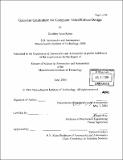| dc.contributor.advisor | Daniel Frey. | en_US |
| dc.contributor.author | Reber, Geoffrey Scott, 1979- | en_US |
| dc.contributor.other | Massachusetts Institute of Technology. Dept. of Aeronautics and Astronautics. | en_US |
| dc.date.accessioned | 2005-06-02T18:38:40Z | |
| dc.date.available | 2005-06-02T18:38:40Z | |
| dc.date.copyright | 2004 | en_US |
| dc.date.issued | 2004 | en_US |
| dc.identifier.uri | http://hdl.handle.net/1721.1/17785 | |
| dc.description | Thesis (S.M.)--Massachusetts Institute of Technology, Dept. of Aeronautics and Astronautics, 2004. | en_US |
| dc.description | Vita. | en_US |
| dc.description | Includes bibliographical references (p. 66). | en_US |
| dc.description.abstract | Computer aided design has allowed many design decisions to be made before hardware is built through "virtual" prototypes: computer simulations of an engineering design. To produce robust systems noise factors must also be considered (robust design), and should they should be considered as early as possible to reduce the impact of late design changes. Robust design on the computer requires a method to analyze the effects of uncertainty. Unfortunately, the most commonly used computer uncertainty analysis technique (Monte Carlo Simulation) requires thousands more simulation runs than needed if noises are ignored. For complex simulations such as Computational Fluid Dynamics, such a drastic increase in the time required to evaluate an engineering design may be probative early in the design process. Several uncertainty analysis techniques have been developed to decrease the number of simulation runs required, but none have supplanted Monte Carlo. Gaussian Quadrature (GQ) is presented here as a new option with significant benefits for many types of engineering problems. Advantages of GQ include: as few as 2*(number of noise factors) simulation runs required to estimate performance mean and variance, errors dependent only on the ability to approximate performance using polynomials for each noise factor, and the ability to estimate gradients without further simulation rims for use in computer aided optimization of mean or variance. The mathematically basis for GQ is discussed along with case studies demonstrating its utility. | en_US |
| dc.description.statementofresponsibility | by Geoffrey Scott Reber. | en_US |
| dc.format.extent | 88 p. | en_US |
| dc.format.extent | 5064158 bytes | |
| dc.format.extent | 5072271 bytes | |
| dc.format.mimetype | application/pdf | |
| dc.format.mimetype | application/pdf | |
| dc.language.iso | eng | en_US |
| dc.publisher | Massachusetts Institute of Technology | en_US |
| dc.rights | M.I.T. theses are protected by copyright. They may be viewed from this source for any purpose, but reproduction or distribution in any format is prohibited without written permission. See provided URL for inquiries about permission. | en_US |
| dc.rights.uri | http://dspace.mit.edu/handle/1721.1/7582 | |
| dc.subject | Aeronautics and Astronautics. | en_US |
| dc.title | Gaussian Quadrature for computer aided robust design | en_US |
| dc.title.alternative | GQ for computer aided robust design | en_US |
| dc.type | Thesis | en_US |
| dc.description.degree | S.M. | en_US |
| dc.contributor.department | Massachusetts Institute of Technology. Department of Aeronautics and Astronautics | |
| dc.identifier.oclc | 56547344 | en_US |
